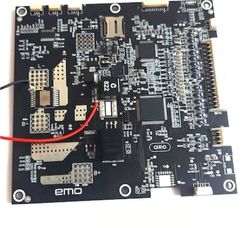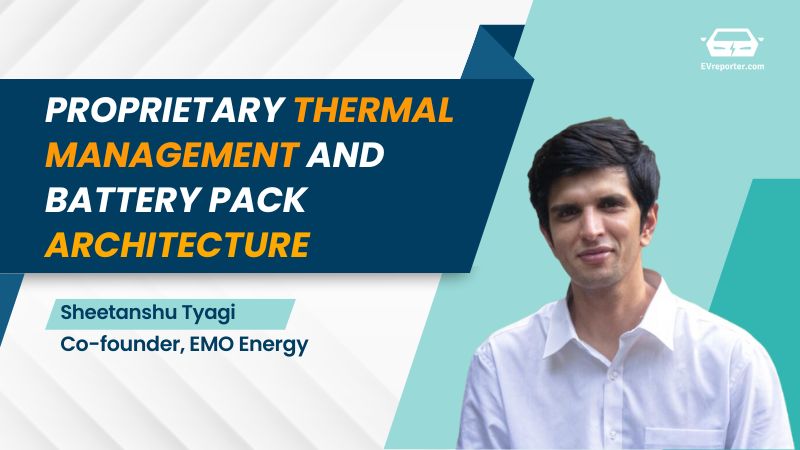Understanding light EV battery pack design approach of EMO Energy
Founded in Feb 2022, EMO Energy is a Bangalore-based Lithium-ion battery technology start-up focused on supplying battery packs for light electric vehicles, starting with the e-2Ws used for hyperlocal deliveries. They claim a 120% improvement in battery life over popular packs in the market and complete fire safety enabled by their propriety thermal management and pack architecture. This Q&A with Co-founder Sheetanshu Tyagi explores their technology and approach to pack design.
What is EMO Energy’s approach to battery pack design?
Common battery pack designs involve cylindrical or prismatic cells in a cell holder arrangement, spot welded with nickel, and secured in a module with basic BMS connections. While advancements like potting compounds, thermal foams, and phase change materials have improved safety and cooling, there are limitations. Existing battery architectures, even those with water-based cooling, face challenges with indirect contact, multiple interfaces, and limitations in heat transfer.
These approaches are often costly and not ideal for portability and durability required in the two and three-wheeler segment.

Recognizing the need for a fresh approach, we designed a battery pack architecture from scratch with unique features. We use cylindrical cells oriented oppositely to counter thermal runaway, advanced vents, and a fluid-based cooling and safety system. Referred to as immersion cooling, this system circulates fluid within the pack in a specific manner, addressing both thermal cooling and safety considerations. Our approach provides a balanced solution for improved power, safety, and overall lifecycle in our targeted applications.
What is your market readiness right now?
- At the foundational level, we have a portable battery pack for electric 2Ws and 3Ws, for which we are actively engaged in pilot testing, refining software, addressing thermal analysis issues, and conducting real-world tests. The product has reached a stage where we have validated its safety, thermal performance, and lifecycle. We are aggressively introducing it to fleet operators and OEMs and finalizing partnerships.
- Simultaneously, significant efforts are underway for high-voltage systems catering to tractors, mining, and construction. These areas haven’t received as much research attention from the industry as passenger cars or buses. Our modular approach allows us to leverage our technology for energy storage for these high-voltage vehicles. In the pilot phase, we are testing a battery pack of up to 60 kilowatt-hours with a few companies.
What are the performance and safety metrics for your 2W/3W battery pack?
- In terms of safety, we have executed at least 25 tests for thermal propagation, employing various cells, orientations, and testing methods, including aggressive scenarios like nail penetration. Adhering to global standards, we continually enhance our fluid, pumping, and control systems to monitor and predict cell behaviour. Our safety standards include no more than 10 to 15 seconds of smoke venting with no visible fire or explosion.
- Regarding performance, we have been engaged in year-long vehicle testing, accumulating over 500 cycles on the road for multiple vehicles. This extensive real-world data aligns well with laboratory data, which includes testing multiple cells and packs for up to 2000 cycles. The observed degradation rate is approximately 1 per cent every hundred cycles, resulting in an overall degradation of around 20 per cent after 2000 cycles.
Our use of NCA chemistry aligns with our ability to manage thermal propagation, validate road data, and leverage our thermal system, algorithms, and BMS platform for life extension.
Can you tell us more about your choice of cell chemistry and form factors?
- For two-wheelers requiring portable packs, weight and volume are critical factors. We prioritise achieving the smallest form factor to ensure compatibility with various vehicles, making it versatile for fleet applications. NCA chemistry is our preferred choice for two-wheelers due to its ability to deliver substantial power with an acceptable lifecycle despite being costlier than LFP. While we have explored LFP for two-wheelers, the compromise in weight and volume led us to prioritize NCA.
- Given its cost-effectiveness, larger packs for three- and four-wheelers exclusively use LFP, with prices below $100 per kilowatt-hour.
- We are also exploring sodium-ion chemistry, collaborating with companies in China to monitor advancements. We acknowledge that this chemistry’s lifecycle and overall reliability are still in the early stages, so we plan to implement it next year.
- Regarding the form factor, we have primarily utilized cylindrical cells. The ease of supplier changeability offered by cylindrical cells allows us the flexibility to switch suppliers or countries seamlessly if required. Plus, the modularity and scalability of cylindrical cells provide flexibility. For instance, using the same form factor for LFP and sodium-ion cells within a specific range ensures adaptability without significant tooling or capital expenditure changes. While we are also exploring prismatic cells, the current reliance on cylindrical cells offers a pragmatic solution, considering the challenges in securing specific cell types, such as prismatic LFP, which is highly demanded globally.
How does the cost of EMO Energy’s packs compare to more common battery packs?
We are highly competitive from a cost standpoint. The industry standard is nearly INR 18,000 per kWh for 2Ws and INR 15,000 per kWh for 3Ws. Our pricing aligns closely with these benchmarks, and our ability to fluctuate based on volume and scalability reinforces our competitiveness.
A key differentiator is that, apart from the cell, every component is developed from scratch – from cell holder materials to connection methods, bus bars, containers, and even plastic parts. This approach allows us to optimize costs and maintain tight control over every process, as all manufacturing occurs in the same facility where assembly takes place.
Our strategic use of standard chemistries, with the cost of cells less than $2 each, coupled with the lifecycle advantages derived from these cells, enables us to offer a Total Cost of Ownership advantage. This positions us at a premium level and allows us to adhere to market standard pricing.
Please tell us about your current production set-up and manufacturing scale.
We have a factory in Mysore. It boasts a complete assembly line, incorporating plastic injection moulding and casting within the same campus. We have implemented automation for various crucial processes such as cell sorting, applying glue to cell holders, busbar glueing, wire bonding, UV curing, and pack testing. The efficiency of these automated processes allows us to produce 25 to 30 packs daily, with plans for significant scaling in the coming months. Currently, we are fulfilling orders for multiple fleet operators from this facility. I want to let you know that this is not a prototype setup; our production pack is fully tooled, using final production tooling for every component in the assembly process.
Can you explain EMO’s thermal management process and battery pack architecture?
Thermal management – The battery pack is optimized through the coordination of the fluid, electronics, sensors, and the control system. The entire battery pack is immersed in a thermally conductive fluid with a high specific heat capacity, allowing for effective heat absorption and rejection. Multiple pumps and heaters facilitate the controlled flow of fluid through the pack, ensuring uniform temperature distribution and efficient heat transfer.
The heat rejection process involves channelling the fluid around the aluminium surface, which acts as a heatsink, ultimately dissipating heat into the atmosphere. This design establishes a direct and efficient conduction path from the cells to the fluid to the housing and finally to the air. Even during high-rate discharge or charge, the system maintains a temperature within 1 degree Celsius. The chosen fluid, a mineral oil-based compound with a thermal conductivity of 0.2 to 0.3 watts per meter kelvin, enhances heat transfer. Although it absorbs about 30 per cent less heat than water, the advantage lies in the absence of multiple interfaces, simplifying the heat rejection process.

A comprehensive monitoring system with multiple sensors ensures the pack’s temperature stability. A vapor chamber in the middle of the pack measures temperature across every cell, triggering an automatic cutoff if any cell exceeds a designated temperature. This activates fans in an overflow mode, rapidly rejecting fluid to prevent excessive temperatures.
The battery pack for hyperlocal 2W fleet vehicles need to endure around 3000 cycles, support fast charging, be portable, lightweight, compact and rugged. Moreover, it must function efficiently in a wide temperature range, from 45 to zero degrees. Embracing immersion cooling addresses all
these requirements effectively.
Our 13 kg, 2 kWh battery pack for e-2Ws stands out as lightweight compared to competitors. With additional features like a robust 12V outlet for external devices, our vision is for this pack to become the standard in the energy market, particularly for the hyperlocal delivery segment.
Battery pack architecture – The pack’s structural design incorporates rubber dampers and an eggshell construction with eight suspension points, offering shock absorption and protecting cells and wire bonds from external impact. This design departure from traditional press-fit arrangements
aims to enhance durability, especially in scenarios involving drops or abuse.

Additional features, such as GPS, display, and pressure-activated vents, contribute to the mechanical aspects of the pack. Innovative approaches to battery management system (BMS) include fast, passive balancing with two MOSFETs, leveraging the fluid flow throughout the BMS for effective cooling. This redesigned BMS architecture addresses challenges related to cell balancing, temperature control, and reliability, ensuring a more robust and efficient battery pack overall.
What is your opinion on battery standardization for swapping use case?
In my opinion, three things should be standardized – The connector, the battery pack form factor, and the communication protocol.
I feel there’s nothing wrong in standardizing the above three aspects. Even today, we are using a standard Chogori connector, a cubish form factor, and the communication protocol is a derivative of an already existing Chinese CAN matrix. Those are already virtually standards today, without anybody pushing these things into the market. At least in the fleet segment, 90 per cent of the two and three-wheelers are already using similar systems.
When there are so many OEMs on the vehicle side and so many companies on the fleet side, linking all of those is difficult. If there was one standard, our internal technology could stand out and give better performance, safety, and a better life cycle to command a specific place in the system.
We are happy to work through at least three standards as long as they don’t define what you do internally in the pack.
Also read: EMO Energy raises $1.2M seed funding for its battery technology platform
This interview was first published in EVreporter Jan 2024 magazine.
Subscribe today for free and stay on top of latest developments in EV domain.






